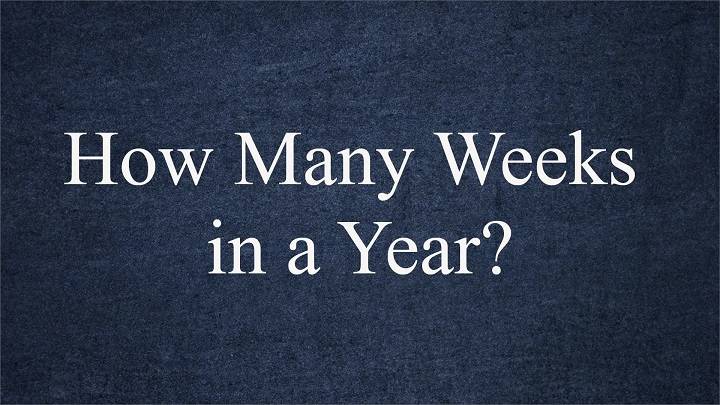The concept of a year and its division into months, weeks, and days is fundamental to how we measure time. While most of us are familiar with the idea that there are roughly 52 weeks in a year, the details behind this calculation and its implications can be quite fascinating. This comprehensive blog post will delve into the intricacies of how we determine the number of weeks in a year, the history and variations of calendars, and the practical implications of these time divisions.
Understanding the Basic Calculation
The Gregorian Calendar
The Gregorian calendar, introduced by Pope Gregory XIII in 1582, is the calendar system used by most of the world today. It replaced the Julian calendar to correct inaccuracies and better align the calendar year with the solar year.
Days in a Year
A standard year in the Gregorian calendar consists of 365 days. However, to account for the extra approximately 0.25 days per year, we have leap years with 366 days. Leap years occur every four years, except for years that are divisible by 100 but not 400.
Weeks in a Year Calculation
To determine the number of weeks in a year, we divide the total number of days by the number of days in a week (7 days):
- Standard year: 365 days ÷ 7 days/week ≈ 52.14 weeks
- Leap year: 366 days ÷ 7 days/week ≈ 52.29 weeks
Thus, in a standard year, there are 52 weeks and 1 day, and in a leap year, there are 52 weeks and 2 days.
Historical Context of Calendars
Ancient Calendars
Before the Gregorian calendar, various ancient civilizations developed their own calendar systems based on lunar and solar cycles. The Egyptians, Babylonians, and Chinese all had calendars that influenced later developments.
The Julian Calendar
The Julian calendar, introduced by Julius Caesar in 45 BCE, was a significant step towards the modern calendar. It had a 365-day year with a leap year every four years, but it overestimated the solar year by 11 minutes, leading to a drift over centuries.
The Adoption of the Gregorian Calendar
The Gregorian calendar corrected the Julian calendar’s drift by adjusting the leap year rules. Its adoption varied across countries, with some switching immediately and others, like Britain and its colonies, not adopting it until 1752.
Variations in Weeks and Years
ISO Week Date System
The ISO week date system, part of the ISO 8601 international standard, defines a week as starting on Monday and includes 52 or 53 weeks in a year. Week 1 is the week containing the first Thursday of the year.
Week Numbering Systems
Different cultures and organizations might use varying week numbering systems. For example, the US typically starts the week on Sunday, while Europe often starts on Monday. These differences can affect business operations, especially in international contexts.
Leap Years and Week Calculations
Leap years add complexity to the calculation of weeks. For example, a year that starts on a Thursday and is a leap year will have 53 weeks according to the ISO week date system.
Practical Implications of Weekly and Yearly Calculations
Business and Financial Planning
Businesses often use weeks as a fundamental unit of time for planning, scheduling, and reporting. Understanding the number of weeks in a year helps in forecasting, budgeting, and performance tracking.
Education Systems
Academic calendars are typically structured around weeks. Schools and universities plan their semesters, holidays, and examination periods based on weekly divisions.
Healthcare and Employment
In healthcare, patient appointments, treatment cycles, and employee schedules are frequently planned on a weekly basis. Similarly, employee contracts, payroll systems, and shift rotations often rely on the week as a unit of time.
Cultural and Religious Significance of Weeks
Religious Observances
Many religions have weekly observances that play a crucial role in their practices. For example, Christianity observes Sunday as a day of rest and worship, while Islam observes Friday for communal prayers.
Cultural Festivals
Several cultures have festivals and events that recur on a weekly basis or are organized around the concept of weeks. Understanding the number of weeks in a year can help in planning and celebrating these events.
Historical Traditions
The seven-day week has deep historical roots, with influences from the Babylonians, who associated each day with a celestial body, and the Jews, who observed a seven-day creation cycle.
Scientific and Astronomical Considerations
Solar vs. Lunar Calendars
Solar calendars, like the Gregorian, are based on the Earth’s orbit around the Sun, while lunar calendars, like the Islamic calendar, are based on the phases of the Moon. The difference in these systems can affect the calculation of weeks and years.
Astronomical Events
Understanding the length of the year and the number of weeks helps in predicting and planning for astronomical events like eclipses, solstices, and equinoxes.
Seasonal Changes
The division of the year into weeks helps in tracking seasonal changes, which is crucial for agriculture, climate studies, and environmental planning.
Technological and Modern Applications
Calendar Software and Apps
Modern technology, including calendar software and apps, relies on accurate calculations of weeks and years to provide scheduling and planning tools. These tools often allow customization based on different week start days and numbering systems.
Data Analysis and Forecasting
Businesses and researchers use weekly data for analysis and forecasting. Understanding the exact number of weeks in a year ensures accurate data segmentation and trend analysis.
Project Management
Project management methodologies, such as Agile, use sprints that are typically measured in weeks. Accurate week calculations are essential for effective project planning and execution.
Educational Perspectives
Teaching Time Concepts
Educators use the concept of weeks and years to teach time management and planning skills. Understanding these units helps students grasp broader concepts of time and its measurement.
Curriculum Planning
Schools and universities plan their curricula based on weeks, ensuring that instructional time is evenly distributed across the academic year.
Extracurricular Activities
Extracurricular programs, such as sports and clubs, are often organized on a weekly schedule, helping students balance their academic and extracurricular commitments.
Psychological and Social Impacts
Perception of Time
The division of the year into weeks affects how people perceive time. Weekly routines and schedules provide structure and predictability, which can impact productivity and mental well-being.
Work-Life Balance
Understanding the number of weeks in a year and how to manage them effectively can help individuals achieve a better work-life balance. Planning vacations, holidays, and personal projects around weekly schedules can enhance life satisfaction.
Seasonal Affective Disorder (SAD)
For those affected by Seasonal Affective Disorder, the division of the year into weeks can help in planning treatments and activities to mitigate the symptoms during specific times of the year.
Future Developments in Time Measurement
Calendar Reforms
There have been proposals for calendar reforms to create more uniform and predictable year structures. These include the World Calendar and the International Fixed Calendar, which aim to simplify the division of the year.
Technological Advancements
Advancements in technology might lead to new ways of measuring and understanding time. Quantum clocks, for example, offer unprecedented accuracy and could influence future calendar systems.
Space Exploration
As humanity ventures into space, the concept of weeks and years might need to be re-evaluated for extraterrestrial environments. For instance, the length of a day on Mars is different from Earth, which would affect how we measure weeks and years on other planets.
The Fascinating World of Time Measurement
The question of how many weeks are in a year opens up a fascinating exploration of time measurement, calendar systems, and their implications across various aspects of life. From historical developments and cultural significance to scientific considerations and modern applications, understanding the division of time enhances our ability to plan, organize, and appreciate the world around us.
Related Post:
Dallas Mavericks vs. Boston Celtics: Analyzing Player Stats in Their Latest Matchup
Timberwolves vs. Denver Nuggets: Analyzing Player Stats in Their Latest Matchup
What Dinosaur Has 500 Teeth? A Comprehensive Look at Nigersaurus
Whether you’re a student learning about the calendar, a professional planning projects, or simply someone curious about the intricacies of time, this exploration highlights the importance and complexity of how we measure and perceive the passage of time. As we continue to innovate and expand our horizons, our understanding of time and its divisions will undoubtedly evolve, offering new insights and opportunities for both individuals and society as a whole.





